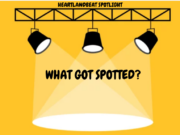Aug. 2: Crop Management Diagnostic Clinic: Precision Ag Training, ARDC (now ENREC) near Mead, 8-4pm RSVPhttp://ardc.unl.edu/cmdc.shtml
Aug. 3-6:Â York County Fair
Aug. 4:Â Project Sense Field Day, Little Blue NRD, Karl Wiedel farm near Hebon, NEÂ 11 a.m.-1 p.m.
Aug. 7:  Project Sense Field Day, Lower Platte North NRD, Matt Bailey farm near Schuyler, NE, 11 a.m.-1 p.m.
Aug. 8: Soybean Management Field Days, North Platte. RSVP:  http://ardc.unl.edu/soydays
Aug. 8-9:Â Nebraska Grazing Conference, Kearney
Aug. 9: Soybean Management Field Days, Ord. RSVP: http://ardc.unl.edu/soydays
Aug. 9:Â Nebraska Cover Crop Conference, during Lancaster Co. Fair at Fairgrounds
Aug. 10: Soybean Management Field Days, Auburn. RSVP:  http://ardc.unl.edu/soydays
Aug. 10-13:Â Seward County Fair
Aug. 11: Soybean Management Field Days, Tekamah. RSVP:  http://ardc.unl.edu/soydays
Aug. 14: Project Sense Field Day, Lower Loup NRD, near Monroe, NE, 5 p.m.-7 p.m.
Aug. 16: Project Sense Field Day, Central Platte NRD, Ken Seim farm near Chapman, NE, 10 a.m.-Noon
Aug. 18: Rain Garden Installation Design Workshop for landscape professionals, Earl May in Columbus, Contact Kelly Feehan kfeehan2@unl.edu
Aug. 22: Project Sense Field Day, Upper Big Blue NRD, Cole Anderson farm near Beaver Crossing, NE, 11 a.m.-1 p.m.
Aug. 23: Crop Management Diagnostic Clinic: Soybean Production Training, ARDC (now ENREC) near Mead, 8:30-5pmRSVP http://ardc.unl.edu/cmdc.shtml
Aug. 24: York County Corn Grower Plot Tailgate, 5-7pm, 1416 Road I, York County.
Aug. 24: Crop Management Diagnostic Clinic: Corn Production Training, ARDC (now ENREC) near Mead, 8-4pm RSVPhttp://ardc.unl.edu/cmdc.shtml
Aug. 24: York County Corn Grower Plot Tailgate, 5-7pm, 1416 Road I, York County.
Farm Finance Clinic Sites and Dates To sign up for a clinic or to get more information, call Michelle at the Nebraska Farm Hotline at 1-800-464-0258.
Crop Updates: Southern rust was found in more area counties this past week including Saline, Hamilton, Clay, and Nuckolls with a suspected sample from Polk. Again, I’d like to thank our industry partners and consultants for submitting samples! Weather conditions have been favorable for its development. All counties where a sample has been confirmed either by the UNL Plant and Pest Diagnostic lab or educators like myself are highlighted on this site: http://ext.ipipe.org/. We’re unsure why the old Pipe site no longer is being used but we’re seeing the wrong maps being shared on Twitter; please go to this website for the latest county confirmations. There is quite a bit of common rust in the upper to mid canopies. Southern rust this year has always appeared as very small and flat, tan to orange colored pustules in tight clusters. Common rust often is brick-red colored but has sometimes also appeared orange and will always be larger sized pustules.
I also started seeing gray leaf spot (gls) with small lesions in lower canopies of plants in more susceptible hybrids this week. Be sure to use a hand lens to ensure that you’re not confusing gls with bacterial leaf streak (bls) or common rust. Old common rust lesions can look like gls and using a hand lens will allow you to see if there’s old raised pustules within the lesion or not. Gray leaf spot will have blunt margins as the lesion progresses whereas bacterial leaf streak will have wavy margins.
If you’ve already applied fungicides to your fields, please continue to scout them. I confirmed samples in two different counties this past week which were sprayed with fungicide 7-13 days prior and had live southern rust spores on them. There’s a number of reasons why this could be including avoiding certain areas of fields, location in canopy, etc. Those fields are being watched by crop consultants. I’m also seeing spidermites and aphids in fields. Severity varies, but start by looking around the backsides of leaves near the midribs for spidermites. Also seeing spidermites in lower canopies of soybean fields in the southern two tiers of counties. Threshold and treatment information in this week’s CropWatch at http://cropwatch.unl.edu.
For those considering putting up silage for drought-damaged corn or for other concerns regarding drought, please see this week’s CropWatch and all our archived drought information at: http://cropwatch.unl.edu/crop-management-drought. Â
We also have a new disease of corn confirmed in Nebraska called diplodia leaf streak. It’s considered a minor disease of corn and I haven’t seen any yet. It can look very similar to Goss’ wilt and also northern corn leaf blight, so please be sure to check out CropWatch for more information! Also, it seems like I have bad news all the time, but hopefully the good news is that you’re aware of things to look for in your fields! Ultimately, check out CropWatch at http://cropwatch.unl.edu!
Butterflies? This past week in particular, orange/black butterflies have been flying across roads, in fields, driveways, and homeowners’ gardens. They tend to be especially heavy south of HWY 4, but they’re pretty much everywhere in the area now. While there most likely are some monarchs as well, if you look closely, the majority are painted lady butterflies. These are the adults of the thistle caterpillars which have been feeding in soybean fields for well over a month now. I will share more on them next week but for the time being, we need to see if they are laying eggs in soybean fields or if they will migrate. Economic threshold for soybean defoliation at reproductive stages is 20% with insects present. Dr. Justin McMechan produced a nice infographic on this in this week’s CropWatch.
Solar Eclipse and Nebraska Agritourism Liability: The following is information provided by Dr. Dave Aiken, Extension Ag Law and Policy Specialist. “As thousands of tourists are expected to visit Nebraska to view the August 21 solar eclipse, some rural landowners may be planning to open up their land for camping and eclipse viewing. If you’re one of these landowners, you may want to brush up on potential liability issues. Landowners have legal protection against tourist personal injury liability if they do not charge a fee to campers or eclipse viewers. If they do charge a fee, they must meet 2015 Nebraska agritourism legal requirements in order to reduce their injury liability risk.
Why is agritourism liability important? Property owners may be liable for damages resulting from injuries occurring on their property. A common example would be a slip-and-fall lawsuit against a retail store. This “premises liability†is not limited to business premises; however, it basically extends to all property, including farm and ranch land.
So if someone comes onto my property, or into my home, and is accidently hurt, I could be liable? That’s right! Not automatically liable but certainly potentially liable.Â
And if I am a farmer or rancher and someone comes onto my property to camp and watch the eclipse, I could be liable for injuries then as well? Yes, although a 1965 Nebraska statute limits your liability if you don’t charge the campers or eclipse viewers a fee.
But if I do charge a fee, then I could be liable if a camper or eclipse viewer gets hurt? Correct, and that’s a good example of why the 2015 Nebraska agritourism law was adopted.
So how do Nebraska landowners get this limited agritourism liability protection? You must post your property with the specified agritourism liability signs, and include the same language in any agritourism activity contract, like a camping lease. The landowner also must exercise reasonable care to guard against unusual dangers associated with the property; maintain the property, facilities and equipment; train and properly supervise any employees; and comply with any related state or local legal requirements (e.g., capping an abandoned well).
Are there other legal options? Yes. Another common option is a written liability waiver. You can get more information about this study in a recent University of Nebraska news release, Great Plains’ ecotourism initiative produces liability study, and can get specific language required for the agritourism liability sign and suggested written liability waiver language in a report on the study, Rural Landowner Liability for Recreational Activities in Nebraska, by Anthony Schutz.
In summary, you should contact your insurance agent regarding whether your current liability insurance will cover any eclipse-related incidents. Your attorney can advise you regarding agritourism liability, agritourism leases, and agritourism liability waivers.â€
York County Fair: Reminder that this week is the York County Fair from August 3rd-6th! More information at: http://www.yorkcountyfair.com/.



































